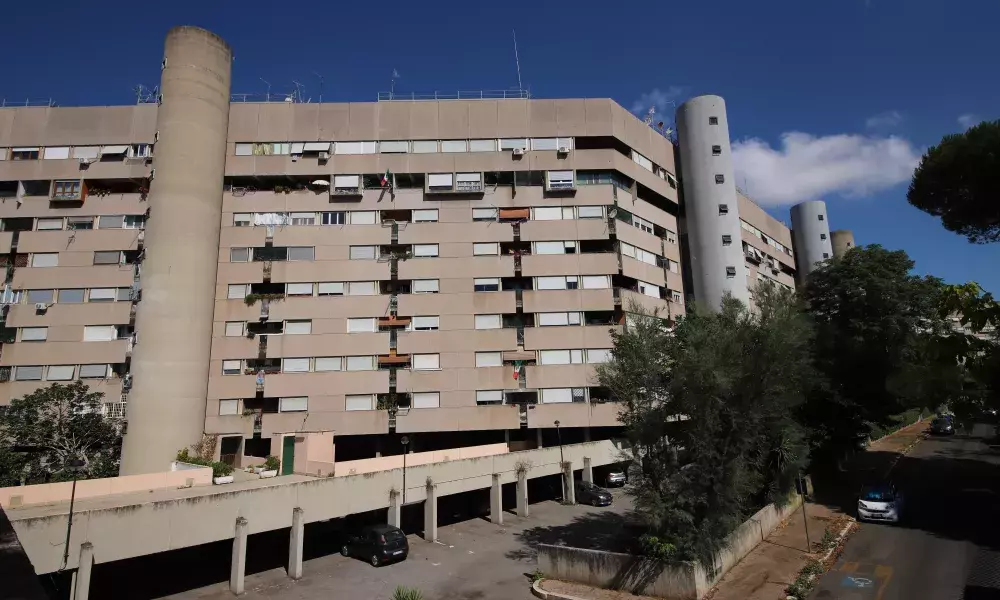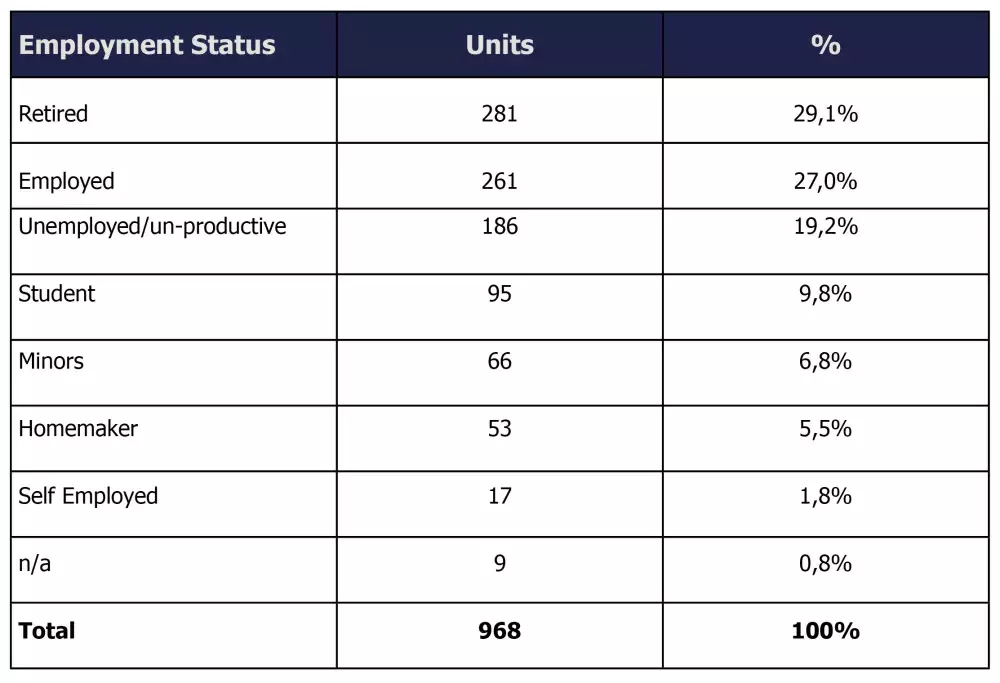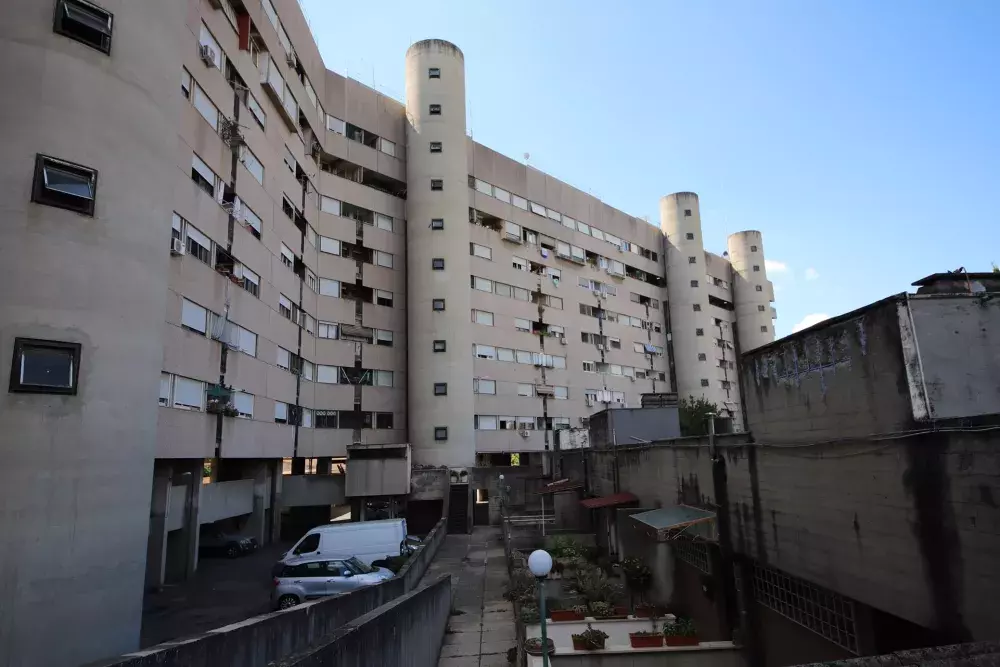
The Vigne Nuove neighbourhood
Vigne Nuove is one of the 114 public housing districts built in Rome between the late 1960s and 1990s, in the wake of a very strong local right-to-housing movement and to respond to a dramatic housing crisis affecting the whole city
Developed in the 1970s, Vigne Nuove’s original design by architects Lambertucci and Passarelli was based on a comprehensive concept that integrated residential units (of different, sometimes experimental, typologies) and non-residential (retail, offices, or services) functions at the bottom floors along with public and green spaces all interconnected by an internal pedestrian pathway.
In the reality, however, the concept was never fully implemented as planned, in particular for what concerns the areas dedicated to non-residential functions, public services, and facilities. Even before the complex was officially inaugurated and the units formally assigned by the Municipality and its public housing agency (ATER), several non-residential units have been occupied either by small informal productive activities or converted into makeshift housing, while ground-level parking spaces started being used for all sorts of illicit trades.
Throughout the years, also due to a significant absence and idleness of the public institutions, the complex was left to its own fate and progressively grew into a state of isolation and abandonment.
According to the last available data,[1] Vigne Nuove is home to nearly a thousand inhabitants, most of which (39,6%) were born in or before 1964; 33,1% between 1988 and 1965; 16,3% between 2006 and 1989; and 11% were born in or after 2007.
In terms of employment status, the neighbourhood registers a rather high concentration of retired (29,1%) and unemployed (19,2%) people against a 28,8% of the total population that is either employed of self-employed.


[1] Official census data as of 31.12.2022
Core issues in Vigne Nuove
The Vigne Nuove neighbourhood is rather disconnected from the rest of the city, giving it the appearance of an "island" or, as many locals describe it, a "spaceship that has landed from the sky”. This sense of isolation is more than just physical; it pervades the lives of the residents, who are predominantly from low-income backgrounds, with a significant number being retired or unemployed. The economic struggles faced by these individuals are compounded by a longstanding neglect from institutional authorities, which has left the area without much-needed support and resources.
For many years, the neighbourhood has been left to fend for itself, with little to no presence of governmental or institutional assistance. In the absence of formal support, powerful local leaders have stepped in to fill the void, though often in informal and unregulated ways. This lack of official oversight has led to numerous issues. Non-residential units have been illegally occupied, with some being converted into makeshift housing and others being taken over for informal business activities. Furthermore, the parking spaces and garages at the lower levels of buildings have become hubs for various illicit activities, including drug dealing, smuggling, and the storage of stolen vehicles.
The consequences of these conditions are profound. The challenging environment and the absence of institutional support have led to a high incidence of mental health issues among the residents, particularly the youth. Feelings of isolation and a lack of opportunities contribute significantly to these mental health problems, manifesting in anxiety, depression, behavioural issues, and problems related to drug consumption and addiction. The young people in Vigne Nuove face a particularly harsh reality, growing up in an introverted environment that offers little hope and few prospects for the future. This pervasive sense of hopelessness exacerbates their mental health struggles, creating a vicious cycle that is difficult to break without significant and sustained intervention.
The main goals of We-Z
Against this background, the We-Z project aims to transform the Vigne Nuove neighbourhood into a vibrant, integrated community, by acting on the urban environment as a means to address and improve mental health issues and well-being. In this context, the project will reclaim a number of illegally occupied units and restore them to their originally planned uses, such as public services and commerce. This can potentially be achieved also through the establishment of a residents' working cooperative, fostering local involvement and ownership.
One of the core objectives of the We-Z project is to create a Healing Community that supports a participatory, mutual healing process. This approach is designed to enhance the sense of belonging and collective wellbeing among residents, addressing the mental health issues that have been prevalent in the area.
The renewal and regeneration of public spaces are also key goals. The project aims to upgrade pathways and public squares using nature-based solutions and public art, which will foster an inclusive and participatory co-design and co-creation process. These improvements are intended not only to enhance the aesthetic appeal of the area but also to promote community engagement and pride by changing the mood and lifestyle of the neighbourhood.
Another significant goal is to reconnect Vigne Nuove with the rest of the city, particularly with the Tufello neighbourhood. This will be achieved through the participatory regeneration of the so-called Progressive Park, which will act as a bridge between the isolated neighbourhood and its surroundings, facilitating better integration and access.
Overall, the We-Z project aims to improve living conditions by enhancing the quality of the physical environment and expanding opportunities for social and economic activities. Through these comprehensive efforts, Vigne Nuove is expected to transform into a dynamic and cohesive community, offering a better quality of life for all its residents.

Opening the Vigne Nuove lab
The We-Z project’s goals are intricately designed to address the multifaceted challenges of the Vigne Nuove neighbourhood, with a strong emphasis on community engagement as a driving force for transformation and the development of a Healing Community.
The project’s first tangible achievement, the opening of the Vigne Nuove Living Lab, marks a significant milestone in this effort. Strategically situated in the heart of the neighbourhood, the Living Lab symbolizes the beginning of a long-term commitment of the Municipality and ATER to reclaiming illegally occupied spaces and restoring them for public benefit, even after the end of We-Z.
This initiative is not merely about reclaiming physical spaces; it is about establishing a permanent institutional presence that directly engages with residents, fostering mutual trust and laying the foundation for a Healing Community where collective wellbeing and mutual support are prioritized.
By transforming one of the many illegally occupied non-residential units into a space for public use, the project addresses the long-standing issues of neglect and isolation that have plagued Vigne Nuove, setting the stage for a community-led transformation that will enhance the neighbourhood’s overall quality of life.
Identifying and reclaiming the space
The process of identifying and reclaiming a suitable space for the Living Lab was approached with community needs and engagement at its core.
Initially, the project considered reclaiming a former bookshop, which had been illegally used as a storage space by heirs who failed to pay rent to ATER (the Regional Public Housing Agency that owns the entire Vigne Nuove complex).
However, given the lengthy legal process involved, the project opted for an alternative location: an illegal housing unit that had been under judiciary appropriation. This unit was repossessed by ATER and converted into the Living Lab.
The strategic positioning of the Lab, with an open space in front of the entrance, was chosen to facilitate outdoor activities that invite community participation and engagement.
The role and the significance of the lab
The establishment of the Vigne Nuove Living Lab holds deep symbolic significance and is designed as a hub for community engagement. It represents the re-establishment of institutional presence in a neighbourhood long neglected, marking the first concrete step in reclaiming illegally occupied spaces and returning them to public use.
This effort is not merely about reclaiming physical space; it is about creating a vibrant centre where the community can come together, share ideas, and actively participate in shaping the future of their neighbourhood.
The Living Lab will serve as a dynamic space for a variety of purposes, all centred around community involvement. Researchers from the University of Roma Tre will use the space to carry out action-research, involving residents in conversations to understand their experiences and aspirations, as well as a space for students and university training activities and workshops.
The Lab will also host small events, social and cultural activities, and serve as a centre for co-designing spatial interventions, ensuring that residents have a direct hand in shaping their environment.
Additionally, it will provide an open space for ongoing exchanges and interactions, creating a continuous dialogue between the project team and the community, reinforcing the Lab’s role as a catalyst for social cohesion and collective empowerment.
Challenges ahead
The opening of the Lab and the increased presence of project partners in the neighbourhood have immediately generated curiosity and sparked some interest among the inhabitants of Vigne Nuove. However, as the project partners are well aware, settling in and embarking on a collaborative journey with the local community will be a long and complicated endeavour. Decades of complete institutional absence have left a profound mark on the local society. On the one hand, this absence has fostered feelings of abandonment and distrust among residents. On the other, the void left by the public sector in terms of services and management has been partially filled in informal and not always transparent ways. For instance, some long-term residents of Vigne Nuove have allegedly acted as informal intermediaries in the allocation of vacant residential and non-residential units, bypassing legal frameworks and procedures.
In this context, the We-Z project is tasked with addressing a set of complex and intricate challenges.
We-Z’s ambitious goal of reclaiming illegally occupied spaces in Vigne Nuove involves disrupting the status quo and, with it, the delicate balance of habits, practices, and power relationships that have thus far governed many aspects of life in the neighbourhood. This could potentially lead to conflicts with illegal occupiers and informal community leaders. Therefore, project partners will need to carefully develop conflict mitigation strategies to ensure smooth implementation.
At the same time, it will be essential to establish a continuous stream of dialogue and engagement with the residents to progressively build interpersonal relationships, allowing people to express their often-unspoken needs, problems, and possible conflicts. Being open to listening and understanding will be key to gaining trust and acceptance.
Ultimately, having the community on board and willing to participate will be crucial for the success of a participatory, community-oriented project like We-Z.
Video
About this resource
The European Urban Initiative is an essential tool of the urban dimension of Cohesion Policy for the 2021-2027 programming period. The initiative established by the European Union supports cities of all sizes, to build their capacity and knowledge, to support innovation and develop transferable and scalable innovative solutions to urban challenges of EU relevance.
Similar content




